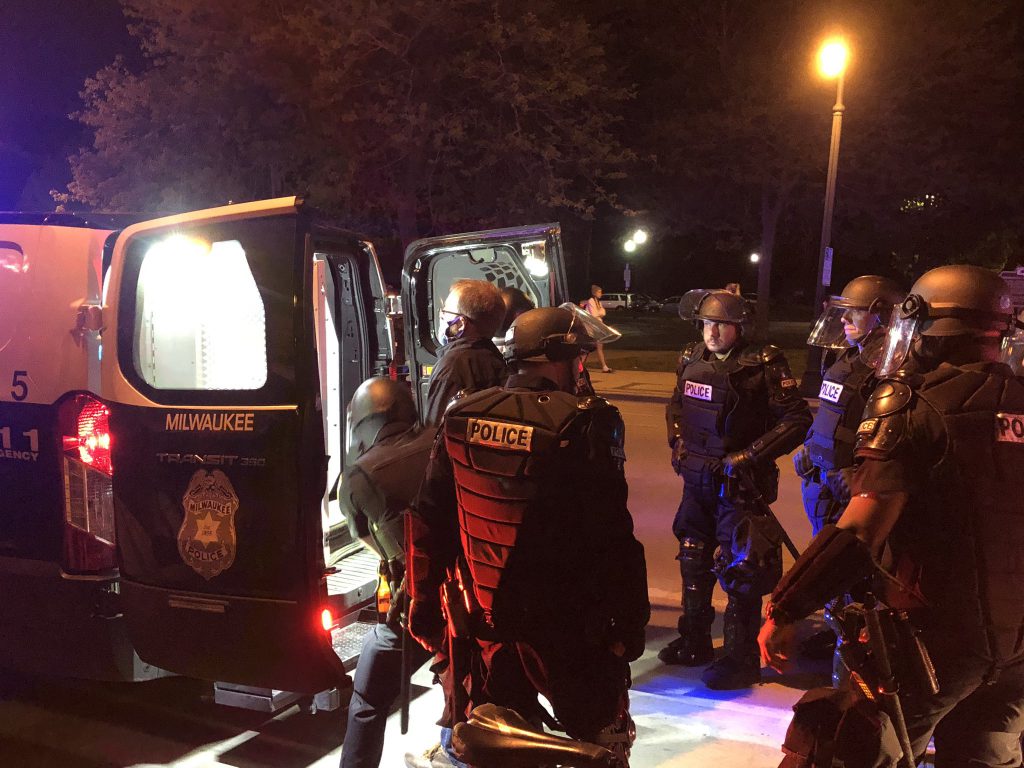Lawsuit Could Change Curfews in State
Suit by Rep. Clancy argued that mayors can't declare curfew without approval of city council members.
“It’s been a really difficult three and a half years,” said Milwaukee County Supervisor Ryan Clancy, who also serves as a representative in the State Assembly. Looking back at the nationwide protests following the murder of George Floyd, Clancy saw himself as “an unknown county supervisor that most people had never heard of.” That changed during one of the first evenings of protests and curfew orders in Milwaukee, when Clancy found himself in a group of more than 70 residents who were arrested by police officers clad in riot gear.
Last week, a federal jury sided with Clancy, granting a settlement that will reshape how curfew declarations are made in Milwaukee. In the future, the common council will be required to be involved in any approval of a curfew. Additionally, the city must ensure that exemptions are added for elected officials and legal observers. The court victory comes as Milwaukee looks ahead to the Republican National Convention and the presidential election in 2024.
A spokesperson for the American Civil Liberties Union (ACLU) of Wisconsin said in a statement to Wisconsin Examiner that “curfews have been used in the past to suppress demonstrations, protests, and other First Amendment protected activity, and so the ACLU of Wisconsin supports limits on when and where curfews may be imposed. Even in those limited situations where a curfew may be appropriate, exceptions for journalists and legal observers are important to provide accountability for police actions.”
Clancy’s arrest occurred during a period of frequent protests in Milwaukee, which drew thousands of residents into the streets. While the daytime protests were largely peaceful, instances of property destruction and looting occurred in the evening hours during the first nights of protests in Milwaukee’. Mayor Tom Barrett declared a curfew to try to stop the damage. Beyond simply ending nighttime protests, the order gave police wider latitude to confront, disrupt, and contain the protests. The curfew declaration, which had been made without the input of the rest of the common council, was not all encompassing. Elected officials like Clancy, as well as credentialed journalists and legal observers were exempted from arrest for a curfew violation.
Clancy knew this the night he was arrested. During the day, he’d served as an ACLU legal observer. Once the curfew was activated, Clancy traded the blue vest he wore as a legal observer for his Milwaukee County Supervisor pin so that he could continue to observe police interactions with the public. At one point, near the border between the suburban community of Shorewood and Milwaukee, police in armored vehicles began arresting people around Clancy. Filming with his phone, Clancy was tackled by an officer, who then confiscated his phone. Video of Clancy’s arrest was later posted to Facebook. A journalist from Urban Milwaukee was the only member of the press to witness the incident.
In June 2021, Clancy announced that he was suing both the city and county of Milwaukee over the officer’s actions. Clancy describes the settlement he reached following a federal jury trial as a bitter-sweet victory. “I am frustrated that it took three and a half years to get there, and to get what I was seeking from the very beginning —just some measure of accountability — but I’m glad that we’re there,” Clancy told Wisconsin Examiner. “It’s important that municipalities are following the law, and they’re not just going off and putting curfews into place. Because we know that when there are curfews in place, that law enforcement will be at their worst. And we even saw testimony during my federal trial where, you know, rather than talking about their own conduct, rather than buckling down and figuring out a way to change, their entire opening statement was ‘everything was terrible, and there was chaos, and there was anarchy, and there was all this danger,’ and really trying to overplay the amount of potential crime that was happening prior to that.”
The protests in Milwaukee when Clancy was arrested were tense and kinetic. On the first night officers at the Milwaukee PD’s District 5 station fired gas and rubber bullets on a crowd that had gathered outside. Over the next few hours, 16 businesses were looted or damaged. National Guard soldiers and Blackhawk helicopters were deployed. Protesters reported what they felt were forms of surveillance by police. During several days of curfew police confronted protesters in the daytime, before the curfew officially took effect. Investigations have also found that during those days, potentially inaccurate information regarding violence against police officers passed through Milwaukee’s intelligence fusion center.
Clancy feels that the city relied on arguments about the danger posed by protesters to appeal to a largely conservative jury pool. “One juror showed up with a Milwaukee Police Department thin blue line hoodie to a trial,” Clancy said. “The judge asked her if she thought she could render a fair and impartial verdict, and she was like, ‘Well, one of my kids was MPD and may have been there actually in [2020].’ So she didn’t seem sure that she could do that. And she was not dismissed by the judge. We had to use one our strikes in order to dismiss that juror.” When Clancy’s lawyers ran out of strikes during the jury selection process many of the jurors had been drawn from rural, conservative communities. Clancy recalled that when the jury pool was asked whether they’d heard of the protests in 2020, just two people raised their hands, and were immediately struck from the pool. “Everybody else did not indicate that they had ever heard of that, which is mindblowing to me,” said Clancy, “including a member of law enforcement who ended up serving on the jury — a retired deputy sheriff.”
Clancy recalled that one of the officers claimed in court that he thought Clancy had been armed with a gun at the time of the arrest. That claim had not been made prior to the trial, even in police reports about the arrest.
Police benefit in cases like his from the automatic deference they receive from the public, Clancy said. “I think that part of that is the mindset that the default is the police are believed, and revered, and are above the law and that anybody who might have gone to a protest just asking that not as many Black people be killed by police is obviously suspect and removed from the jury pool,” said Clancy. “But people who have been in law enforcement or have made public declarations that people shouldn’t be out there protesting are just fine to serve.”
The issues raised by Clancy’s lawyers revolved around the language used to enact emergency declaration orders, otherwise known as curfews. Essentially they argued the local governing body needs to be informed of, and involved in the process of declaring a curfew unless the emergency itself prevents the governing body – such as a common council – from meeting. This was not the case when protests erupted in Milwaukee in May 2020 and endured throughout Wisconsin into the following year.
In August of 2020, a curfew was declared in Kenosha due to protests and unrest following the shooting of Jacob Blake. By the time the curfew ended, militarized law enforcement had descended on the city along with a rag-tag group of armed right-wing militas which patrolled the streets unchallenged by police. Two people were shot and killed by a AR-15 wielding teenager, and another person was severely injured in that incident. Blake’s shooting as well as the deaths, injuries, and millions of dollars in property destruction that followed scarred the city.
A couple of months later in Wauwatosa, a curfew was declared in October, 2020. The city declared the curfew in anticipation of protests after a decision in the shooting of Alvin Cole by a Wauwatosa police officer was released. Mayor Dennis McBride and the police department discussed the curfew order, but the rest of the common council was not included in those discussions. The city council was also left out of curfew discussions in Kenosha. Property damage occurred on the first night of protests in Wauwatosa under the curfew, though not at the level seen in Kenosha.
Clancy, who works both at the local and state levels of politics, hopes his lawsuit will have a domino effect. “My hope is that the precedent set here with the City of Milwaukee, which is the biggest city and biggest police force in the state, settling, that that makes it clear to all municipalities across the state that they have to follow the law,” said Clancy. “And right now the state law is clear, mayors cannot be — and in the case of Kenosha, the sheriff and law enforcement themselves cannot be putting curfews into place. …. It is very clearly illegal for them to do that unless the governing body cannot meet because of the disaster that is in front of them. And in the case of Kenosha, the declaration of that curfew and then the horrific brutality that we saw from law enforcement agencies across the state that converged on Kenosha led to two people being shot. … So yeah the stakes here are really high.”
Lawsuit by a Milwaukee official could change protest curfews in Wisconsin was originally published by the Wisconsin Examiner.






















This story is about a tragedy that is tearing our country apart. On one side are people who believe in peaceful protest and more if necessary. On the other are groups charged with maintaining law and order but have become militarized as they receive “extra” weapons of war from the US Department of Defense. One side demands the other obey the law while the other side in the tradition of the birth of our country has used destroying property as a way to send a message when talking doesn’t work.
December 16, 1773: People in Boston boarded a British ship full of tea and threw all of the chests of tea into the harbor. Attacking the concept of “No taxation without representation,” the iconic Boston Tea Party led to the revolution giving birth to our country. You don’t like protests? Too bad. You don’t like protests where the property is destroyed? Too bad. These acts are fundamental to the creation of our nation and woven into the fabric of this country.
Until we find a way to deal with each other reasonably, Milwaukee will remain a Potemkin Village. In other words, a city that has a pretty facade and empty devastation on the other side. I can’t wait to hear what Mayor Johnson has to say about this case. It’s over, he is free to talk about it. But he won’t. He has yet to deal with any controversial matter for fear of offending someone and losing monetary support and votes. That’s not leadership. The city in court argued what did was correct and lawful. Watch the Facebook video linked above. It is 4 minutes long. Make up your own mind. Ask those running for office, Mayor, City Attorney and in every Aldermanic district if they think this is the way the city of Milwaukee should deal with people. I am guessing most will refuse to answer.